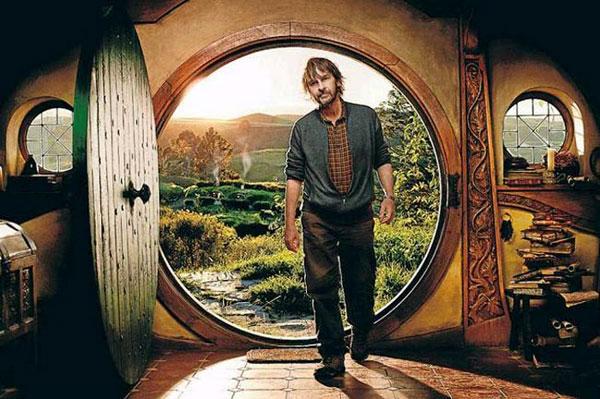Hobbits, Rings, and 48Hz Things

That's the one addition to the longer versions I would have tossed out of hand. Yes, there were others that I felt gave away too much, such as the recruitment of the ghost army. I won't spoil it for you by saying more, but of the three films, The Fellowship of the Ring is the only extended release I would unequivocally choose over the theatrical.
Also, Fellowship looks far better in its extended release than in its shorter form, with significantly better detail. Yes, there is a change in color timing, approved by Jackson, which has caused a real stink in more than one Internet forum. But this is a tempest in a teacup. By and large, the re-release will certainly please fans of the filmsexcept, perhaps, for those who stare at the shelf holding their theatrical DVD boxed set, their extended-edition DVD boxed set, and their theatrical Blu-ray boxed set, wondering how many more times they will be tempted to re-purchase these movies. Conversion to 3D, anyone?
No matter. This is a dynamite package. I'm a major fan of these films, so I'm perhaps not the best person to conclude that they're a milestone in epic filmmaking that Spielberg, Cameron, and Lucas can only wish they might have made.
But I digress. The most interesting discovery in my search involved The Hobbit, Jackson's two-film adaptation of Rings author J.R.R. Tolkien's earlier work. Currently in production for the first film's release in fall 2012, it's being shot on digital video and in 3D. No surprises there. But the kick is that it's also being shot at 48 frames per second, instead of the usual 24fps. The slower frame rate has been a film-production standard since DeMille and Griffith walked the earth, chosen mainly as an achievable compromise between jerky motion and eating up too much expensive film stock.
But with today's digital photography and digital projection, there's no film stock to worry about, only increasingly cheap storage. Actually, you might have already seen productions shot at 48fps or even higher frame rates. Similar techniques have been around for yearsShowscan, for example. But their use has been limited to short features for theme-park rides and attractions. Film cost has been a major barrier to high frame-rate feature films, but with digital cinematography, 48fps is now a realizable goal. While most digital cinemas may not currently be ready to display at that frame rate, it's likely they could be converted at a practical cost. As Peter Jackson describes it:
Film purists will criticize the lack of blur and strobing artifacts, but all of our crewmany of whom are film puristsare now converts. You get used to this new look very quickly and it becomes a much more lifelike and comfortable viewing experience. It's similar to the moment when vinyl records were supplanted by digital CDs.
That last sentence might put audiophile teeth on edge, at least in some quarters, but it will be interesting to see how this all pans out. I've been outspoken in the past about my dislike of frame interpolation, a feature offered on many consumer displaysmostly LCD flat panelsthat simulates smoother motion by producing new, averaged frames between existing ones. How might true 48fps differ? For one thing, the best that interpolation can do with rapid motion is produce additional, equally fuzzy frames between original, fuzzy frames. At true 48fps, where all the frames are real and shot at a faster shutter speed, the blurring for all of the frames will be significantly reduced, increasing the perceived resolution.
Of course, nothing is free. Faster shutter speeds will require faster lenses with wider apertures, possibly reducing depth of field and increasing digital grain and other artifacts. Nevertheless, this could turn out to be a bigger next-big-thing than 3D. It might even do to today's 3D what Cinemascope did to the 3D mania of the early 1950'skill it off. But filmmakers like Jackson will certainly be tempted to use both 3D and 48fps. Hmmm…do I see yet another ticket price increase in our future?
What about true 48fps at home? While most of today's HDTVs can do 48fps by doubling the rate of a 24fps input, they haven't been designed to accept a native 48fps input. But I doubt it would take a major redesign to allow them to do so.
The real problem would involve 48fps sources. How will that challenge the capabilities of our current data carriers? Broadcast, cable, and satellite are probably out, and online streaming in highly unlikely, though downloading to local storage might be a viable approach, as long as you're willing to wait a long time to download a 2-hour 48fps movie. Blu-ray is the only likely alternative, but the current specification does not include 1080p/48. If the only way to squeeze in 48fps would be use higher rates of compression, will that sacrifice more image quality than 48fps adds?
These questions will have to wait until 2013. In the meantime, there's the theatrical release of The Hobbit to look forward to, provided you're near a 48fps-compatible theater. As Jackson concludes:
"…while it's predicted that there may be over 10,000 screens capable of projecting The Hobbit at 48 fps by our release date in December 2012, we don't yet know what the reality will be. It is a situation we will all be monitoring carefully. I see it as a way of future-proofing The Hobbit. Take it from meif we do release in 48 fps, those are the cinemas you should watch the movie in. It will look terrific!"





























































